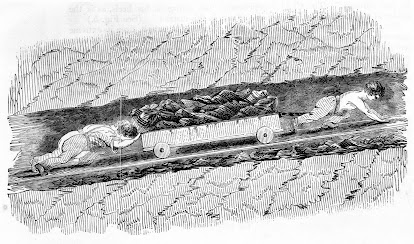As Richard and William grew older and bigger they would probably have been hired as a pair of ‘hurrier’ and 'thruster'. A hurrier’s job was to pull heavy carts of coal away from the extraction point, while the 'thruster' pushed.
By 1861 Richard was 21 years old and still living at Taylors Row, Water Street, Accrington; working as a miner, with his brother John. As a young man Richard would have been working on his own in the mine. He may have continued to work as a hurrier, but could have progressed to the role of getter by the age of 21. Getters were the strongest of the crew and would work getting the coal from the seam, using a pickaxe. The getter was the only job underground that would be done by continuous light, as they needed to see the coal in the rock face.
The family then moved to Habergham Eaves, near Burnley, where they had two further children. There was a coal mine in Habergham, which could have been the mine where Richard worked. The mine closed in 1941, due to a lack of manpower, presumably due to the war.
By the 1871 census the family was living at 56 Lord Street, Burnley (an address that apparently no longer exists). Richard was still working as a collier.
Ten years later and the family had moved again, this time to 18 Lee Street, Burnley. They had had three more children whilst living at this address, before they returned to Accrington. in 1873 Richard marked his 30th year of working underground, in the town of his birth. It might seem odd for a family in this era to have moved so much but it was, in fact, quite normal and common. Families had to go where there was work. Mines, not subject to the rigours of health and safety rules, might collapse, or be mined out, and then workers would have to move to a new place for fresh work. Living conditions were harsh, and families were always on the look out for a way to improve their lot. If there was a better home to live in, or cheaper rooms to rent, they would move. Anything to improve their general health and chances of survival. Also, when we, surrounded by our mass of 21st century belongings, consider moving, we consider the cost of such an endeavour. It was far less costly for the working class of the mid-late 1800s. Often a small push cart was enough to move the meagre possessions of a coaling family, even with all those children!
Whilst life must have been overwhelmingly harsh underground, for Richard, life above ground was no picnic either. Today we might look at the stunning Lancashire countryside, and delight in the verdant hills and big skies, but back in the late 1800s, in the heart of the industrial era, there was little fresh air to experience. Mills and mines, factories and furnaces pumped out pollution, turning the sky black with soot. It would have been nigh on impossible to get washing clean at dry, as it would collect soot as it hung out on lines. This image of Blackburn's sooty sky gives a idea of what people had to put up with.
Richard and Ann’s last child was born in Burnley in 1885, and two years later their eldest daugher, Isabella Holding married Alfred Hodgson, at the Priory, Lancaster. On the marriage certificate her father Richard was recorded as working as a collier.
Sometime later the rest of the family moved away from the coal fields to join Isabella in Lancaster. In the 1891 census the family were living at 24 Salisbury Road, Lancaster, where Richard, after almost 40 years of working underground, finally had an overground job as a general labourer. Lancaster was a
In the 1901 census Richard and Ann were living at 24 Salisbury Road, Lancaster, together. Richard was working out of the home, dealing fish and potatoes. Richard was running one of the original fish and chip shops of England; a small family business run from the front room of the house.
It is thought that the first fish and chip shop was in either London, within the sounds of Bow Bells, or in Lancashire, near Oldham. Around 1863 Mr Lees of Mossely, Lancs served fish and chips from a hut in the market place. He later transferred his business to a shop across the road, and fairly quickly fish and chip shops were springing up in many family homes across the country. The national dish had finally arrived!
 |
| Mr Lees Chip Potato Restaurant in Mossely |
Front room fish and chip shops were commonplace by the late 19th century, and its not surprising that Richard, at the age of 60, was looking for an easier job, that didn't require him to do hard labour, or toe the line for an overbearing boss. Fish and chips was a cheap take away meal that industrial era workers could easily afford, and some say that the Industrial Revolution was fuelled, at least in part, by fish and chips. Watch this wonderful clip to learn more about the early fish and chip industry in Britain!
What a working life my paternal 2x great grandfather, Richard Holding had! Around half a century working underground, and possibly the last decade of his life working as an entrepreneur in a burgeoning industry that was to shape the food culture of the country!
.jpg)









No comments:
Post a Comment